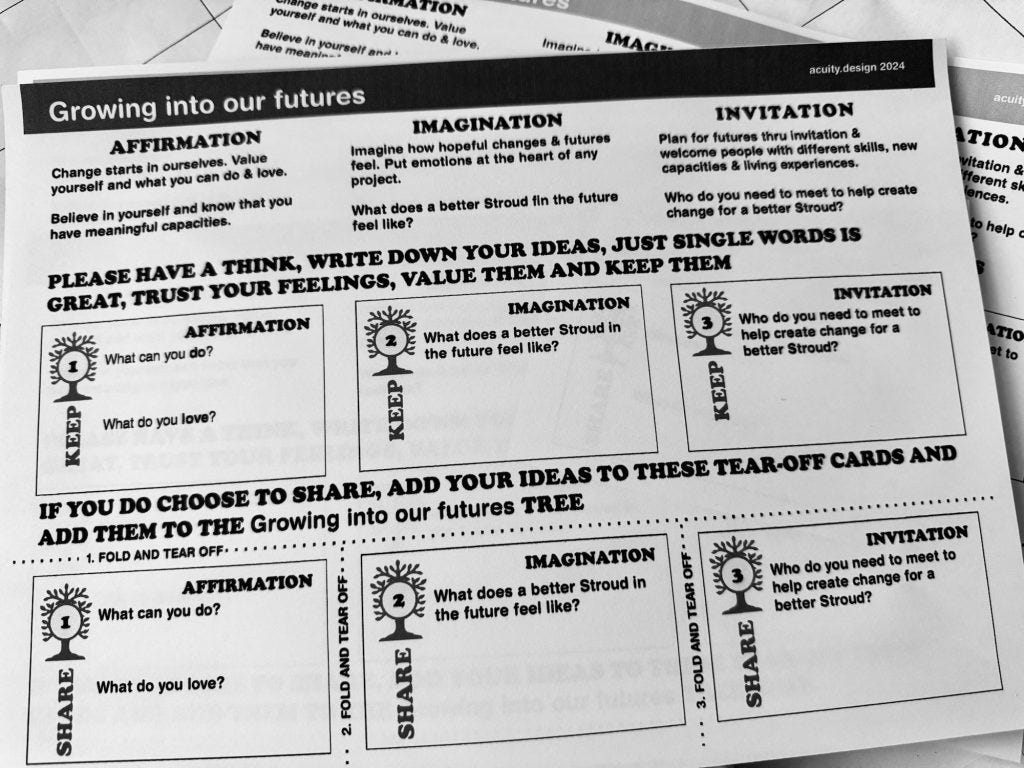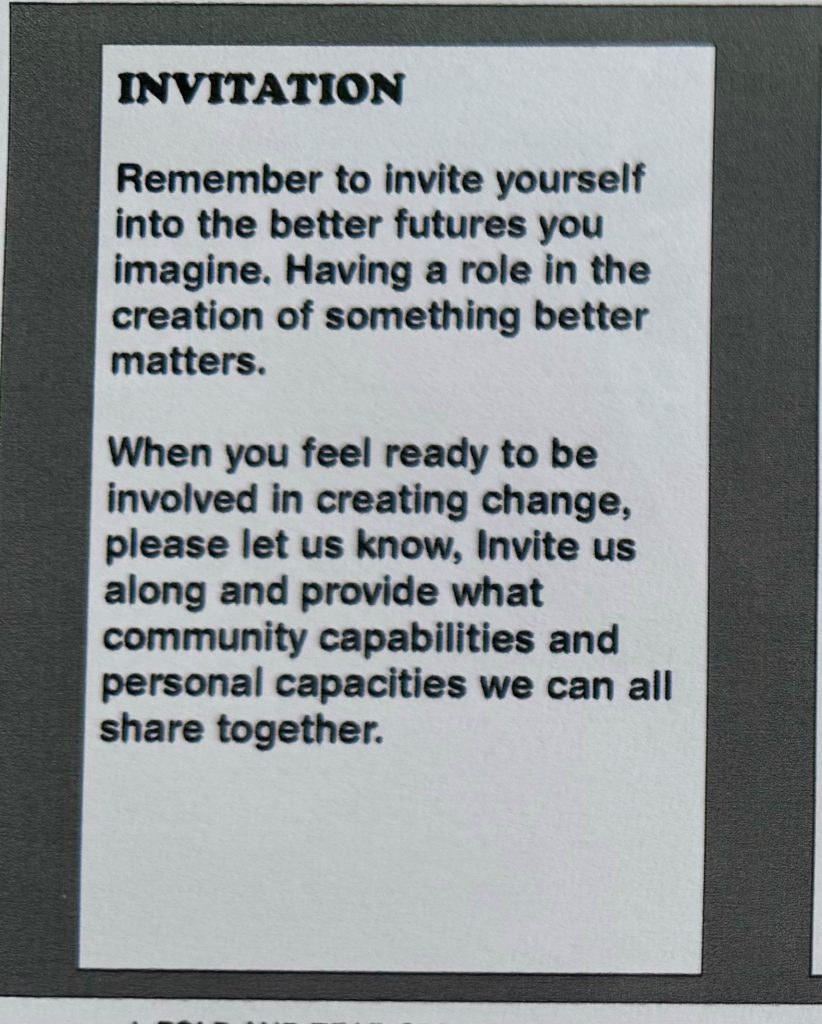
Yesterday, I wrote about the material I am developing for a public workshop in Stroud. That was about one side of the main handout. You can read Asking Not Taking about autonomy, saying No and Keeping.
This post is about the flipside. This is about what the participants take home and what they do next.
Things go backwards now.
Reversing the process

On the front side of the workshop A4 leaflet is a process for imagining change. It starts in affirmation of the person and their skills and ends with invitation of other people with different capacities. Imagining better futures is in the centre. This is a process I have used in many workshops and derives from work for the UK’s Design Council on enabling systemic thinking in the climate crisis.
This front side process runs forwards from the person to the future. It is rooted in their sense of self and becomes about their sense of place and finally sense of community.
The flipside reverses that flow. It is about supporting a person when they have left the moment of the workshop and are back in their own home.
Listening to yourself
I run Active Listening workshops and one point that I make is that being heard by other people is important but hearing yourself is also crucial. Some people never get to be heard and thus they are neither appreciated by others but also never fully appreciate themselves. Being heard by yourself is sometimes a powerful moment.
There is something about this self-recognition in the workshop. It is in the invitation.
Generally I have thought of the invitation as something from person to other people. An invitation to talk, to share and to make.
However, I think now it is also an invitation to the self.
The Affirmation, Imagination, Invitation process came out of a realisation that the systemic thinking tools dealt in a vastness that needed rooting in the person. Otherwise, everything seemed too huge to engage with. Affirmation was a way of explicitly linking a person and their capacities to the complexities of systems and change.
The reason I have rethought the invitation is because I have been reading books on propaganda and authoritarianism. This year there have been Peter Pomerantsev’s How to win an information war and Annalee Newitz’s Stories are weapons. What comes up in both the books, probably more so in the former one, is how much authoritarians offer roles and clear narratives to people who are distressed by systemic change. There is an explanation for what is happening and a future pathway to a solution (however, violent and racist it is). More so there is a role for the person who joins in. They gain a title, perhaps a uniform and an intent. They gain a place in the future.
This is what is missing in many ‘imagine the future’ design processes. We often ask people to imagine a better, hopeful future but they themselves are not explicitly in it. It is all theatre: the backdrops and settings of a future but they themselves are just background figures. Non-Player Characters in gaming terms. They have no active role or purpose in the futures.
This is why people must invite themselves into the futures they imagine in workshops.

The draft text (shown above with typos and other errors) is for a person to think about the workshop, what they did and what they can do. It is an invitation to the self but also a slow invitation to join a community. Rather than rushing a person to join in, let them understand their own contexts and capacities so they join with a sense of their own role and what they can do.
Imagination and Affirmation
Providing time to think about themself, what they imagine and what they feel they can do matters to personal autonomy. It also matters to diversity of ideas and approaches to future problems.
Authoritrians offer clear roles and intents to ‘fix’ problems. It does not make sense to mirror that offer.
Authoritarians seek convergence and compliance yet the futures we face need approaches that require divergence and dissent.
The book The End of Average has a section on companies that employ people in irregular ways. Rather than recruit by defining tasks, stating qualifications and naming titles, they have systems based around people finding their contexts within the place and then saying what their job is (with the agreement of their co-workers). People fill holes, not roles, using their capacities and recognition of contextual needs.
This is where the Imagination and Affirmation parts of the workshop and the flipside process come together. The person uses their imagination to see the holes in the hopeful future and aligns those with their capacities to fill them.
Rather than telling a person what small piece of work they must do to create a better future, use the diversity of people to explore more possibilities and build greater communcal capabilities thru diverse and divergent personal capacities.
Shared imagination is powerful. Shared capacities create communal capabilities that enable systemic change. Start with the person and enable their self-actualisation.
We cannot imagine or build hopeful futures by telling people what they must believe and do. Those are the tools and methods of authoritarians. We need people to believe in their own selves and let them choose to be part of greater communities bringing their ideas and capacitities with them.
That is what the flipside material is about. I need to edit and change it but the sense of invitation, imagination and affirmation is there.